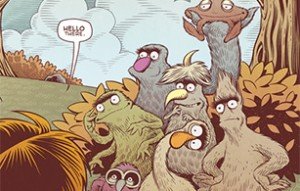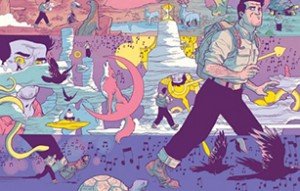Posts made in October, 2015
The Musical Monsters of Turkey Hollow
In 1968, Jim Henson and Jerry Juhl began collaborating on another project that was not meant to be but, if it had been filmed, would have been the first full-length Muppet special, as well as the first time a full Muppet production would be shot on location rather than in a studio. It was meant to be a Thanksgiving show with a cast made up of humans and Muppets. And Jim and Jerry got fairly far into the process. Jim and Don Sahlin built the puppets and even took photographs of them outside in the trees by Jim’s house in Connecticut, to see how they’d look in natural, outdoor lighting, right where he had shot Run, Run with his daughters.
And he enlisted his daughters here again to stand in for the child actors
Read MoreOur Place, Ads, & More
In the summer of 1967, Rowlf was enlisted by Ed Sullivan (again underlining in what high esteem Sullivan held Jim and the Muppets) for yet his next big assignment, as the emcee to a new variety show produced by Sullivan’s production company to air just that one summer–from July 2nd till September 3rd–while most of the rest of TV was on hiatus/in reruns. Along with Rowlf, Our Place also featured an adorably square musical group, The Doodletown Pipers–who would sing overly earnest covers of pop hits–along with the comedy team of Burns and Schreiber, namely Jack Burns and Avery Schreiber, the first of whom would go on to be the head writer on the first season of The Muppet Show, and the second of whom would appear in an episode that first year.
Read MoreTale of Sand
In the late 60s, Jim Henson and Jerry Juhl collaborated on a screenplay called Tale of Sand, a darkly humorous, extremely ambitious work reminiscent of Time Piece in its imagery-heavy, stream-of-consciousness, deliberately nonsensical (in the Lewis Carroll sense of the word) flow and its surrealist depiction of what is essentially an existential crisis on screen, however much larger in scope to the former film, not only because it was intended to be feature-length but due to the sheer complexity of the visuals.
Like Time Piece, it’s more of a plunge into a bizarre fever dream than a narrative, and it’s probable that its weirdness and therefore probable lack of accessibility accompanied with how expensive it would be to produce led to its never having been made.
Read MoreMuppets for IBM
In 1965, IBM hired Jim Henson to make a number of short “industrial” films for their company, which were effectively intended as comedic shorts to break the tedium of long meetings. Later on, Jim would produce similar short pieces called the Muppet Meeting Films which could be used for any corporate client, and some of which were actually remakes of these early bits for IBM. I wasn’t able to get exact dates for all of these films, and some of them I know are from 1965, so I’ll be jumping backwards in the chronology a bit here, but it seemed like it would make most sense in this case to combine them all in one place.
What is likely the earliest of the set is a 4-part film starring Rowlf in which he writes home to his mom, documenting his first year as a salesdog for
Read MoreRipples, Wheels, Etc.
In 1967, Jim Henson made a one-minute short film for “Expo67,” which was a World’s Fair, in Montreal, Quebec. Called Ripples, it is reminiscent of Time Piece in its use of a stream-of-consciousness series of images that flow emotionally rather than logically, however in a much more compressed format, as well as the Bufferin ad in the previous post in its exploration of the human mind. Over the course of the minute, an architect played by Jon Stone–a producer who collaborated with Jim on a Cinderella pilot in 1965, and would later bring Jim on board to Sesame Street, and even later write The Monster at the End of This Book–drops a lump of sugar into his coffee, causing ripples in the glass, which fades to a shot of him by a lake, tossing pebbles into the water, each ripple bringing up images in his mind of architecture and art, moments of great progress throughout history and the then-modern day/future (illustrated via shots of NASA rockets and mission control centers), his home life, and his family. In a few short moments, it establishes ripples of connection between humanity, human progress and achievement, nature, and us.
Read More




